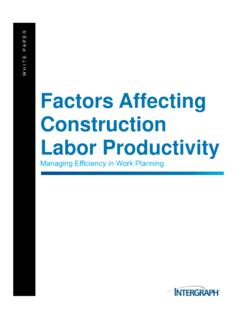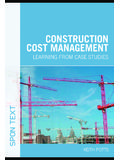Transcription of A guide to modern methods of construction
1 A guideto modernmethods ofconstructionA guideto modernmethods ofconstructionDecember 2006 NHBC FoundationNF 1 Published by IHS BRE Press on behalf of NHBC FoundationDecember 2006 ISBN-13: 987-1-86081-937-7 ISBN-10: 1-86081-937-0 NHBC FoundationBuildmark HouseChiltern AvenueAmershamBucks HP6 5 APTel: 01494 735394 Fax: 01494 735365 Email: guide has been written by Keith Ross, Paul Cartwrightand Oliver Novakovic of the BRE Housing Innovation CentrePREFACEThe NHBC Foundation has been established to help the house building industry to develop innovative and sustainable ways of meeting the demands for newhousing. Its mission is to help set and improve the standard of new homes across the guide is one element of a series that is expected to grow into a valuableresource for everyone in the housing industry from regulators, lenders and insurers, through to designers, planners and builders, and on to clients and aim of the series, in association with our other initiatives, is to add to theknowledge base of the industry and to provide clear, easy to access, informationto assist the industry in meeting the challenges that it faces in these times of rapid change.
2 To this end we will be developing further projects with our partners to further our aims and MacEachraneDirector, NHBC FoundationDecember 2006 ACKNOWLEDGEMENTST hanks to the following individuals and organisations for their technical guidanceduring the preparation of the guide :Phil Brown PACE Timber Systems LimitedPaul Cooke HigginsJohn D Cooper NHBCD avid Flight Como Homes LtdRob GranthamGuinness TrustStephen Proctor Proctor and MatthewsBrendan Ritchie Willmott DixonNeil Smith NHBCKate Symons Jephson HousingGraham Webb Framing SolutionsPhotographsWe would like to express our sincere thanks to the following companies for supplyingphotographs for this guide :Page numberFigureCompany7 Closed timber frame panels being placedSpace4 Ltd7 Concrete panels complete with insulation and half brick claddingMilbank Danilith9 Volumetric unit designed for use in a hybrid systemAdvance Housing Ltd10 Pre-fabricated foundation systemVan Elle Ltd10 Steel framed floor cassette being lowered into placeThe Forge Company10 Roof cassettes being installedMilbank Roofs Ltd12 Concrete being poured into insulating formworkFormworks UK LtdWe would also like to express our gratitude to the following companies for allowing BRE totake photographs on- site , some of which have been used in this guide .
3 Geoffrey Osborne LtdH+H Celcon LtdJohn Laing plcKajima UK Engineering LtdLovellOptima Community AssociationRedrow Homes LimitedSouthern Housing GroupSpaceover Group LtdTaylor LaneTerrapin LtdThe McAvoy GroupA guide to modern methods of constructionIntroduction1 Drivers for building with modern methods of construction1 What are modern methods of construction ?3 Types of modern methods of construction5 Volumetric construction5 Volumetric construction : bathroom and kitchen pods6 Panellised construction systems7 Hybrid construction9 Sub-assemblies and components10 site -based modern methods of construction12 How modern methods of construction fit into the construction process13 The pre- construction process16 Private sector builders16 Housing associations18 Assembling the project team22 Obtaining approvals and developing the detailed design22 Procurement24 Annex: Roles and responsibilities of parties involved in off- site manufacture25 CONTENTSA guide to modern methods of construction This guide is a concise reference tool that combines the experiences of architects, maincontractors, engineers, warranty providers, manufacturers, and BRE who have applied modernmethods of construction (MMC) successfully throughout the construction process.
4 It providesguidance throughout all stages of a project from the development of the outline brief throughto delivery following the advice in this guide is not the only way to achieve a successful project ,you will find valuable guidance here on most situations and commonly encountered for building with modern methods of construction Shortage in housing supplyThe rate of housing supply in areas of the UK, such as the South East where considerablegrowth is forecast, is lower than Government would prefer. High demand for housing in theseareas is pushing up prices, making it more difficult for key workers and those on low incomesto find suitable accommodation. The development of affordable private sector dwellings isoutside the control of Government so the focus has been on stimulating the development ofMMC capacity as a means of increasing the rate of housing Government has approached this aim by specifying that a proportion of dwellingsprocured using public funds, or on Government-owned land, will have to be constructed usinginnovative techniques.
5 In practice this means that a proportion of dwellings built with HousingCorporation grants, or on land owned by English Partnerships, will be built using shortageUnder investment in training in the building industry in recent years has led to overall skilllevels decreasing with potential implications for quality. The situation has been made worse bythe greater use of contract, as opposed to direct, labour. Procurement is often on the basis ofIntroduction1 INTRODUCTION2A guide to modern methods of constructionlowest tender/fixed price meaning there is little incentive for contractors to do more than theminimum required. It is also difficult for main contractors to predict the calibre of operativeused on a job. Recent moves towards partnering and best value approaches may be improving the situation,but those approaches are far from universal. In areas of high construction activity the lack ofsufficient skilled labour is more acute.
6 Most MMC housing is constructed wholly or in part infactories. Since the workforce in factories tends to be direct labour there is a greater incentivefor the employer to invest in training, both for factory based operatives and site erectionteams provided by the about housing qualityIt is difficult to draw firm conclusions about whether construction quality is getting better orworse. There is a perception that build quality is declining, but that is probably due more tohigh profile media coverage of a few examples of poor practice and increasing customerexpectations, than to an overall decline. Conventional construction can, and in most casesdoes, provide good quality housing but there is a general feeling that quality will need toimprove if only to meet the higher performance standards needed to comply with the revisedBuilding Regulations (see below). There is a limit to what can be achieved in terms ofpredictable performance given the adverse working conditions on building sites and a largelycontracted workforce.
7 However, MMC housing manufactured in controlled conditions with adedicated workforce has the potential to provide more consistent to Building RegulationsWhen the Building Regulations were introduced, they were concerned only with the health andsafety of people in and around buildings. More recently the Regulations have been broadenedto cover the performance of buildings, particularly their thermal and acoustic performance. Inthese cases house builders are not only concerned with meeting higher standards, but with theprospect that performance might be tested after construction : this can lead to costly remedialwork if performance falls short of the standard required. Some house builders are looking atMMC as a potential way of providing more predictable performance in the performanceIncreasing emphasis is being placed on the environmental performance of buildings, not onlyin use but also during construction , and the environmental credentials of the materials beingused.
8 One aspect of the construction process that is criticised on conventional sites is the levelof wasted material, either through damage or profligacy. On conventional sites, materials arenormally purchased in bulk and contractors are hired to fit them. There is little incentive for thecontractor (who is usually on a fixed-price contract) to economise on the use of materials. WithMMC, suppliers usually quote a price for manufacture or supply that includes the cost of thematerials, so there is a much greater incentive for them to minimise wastage. There are other environmental benefits particularly for manufactured dwellings because muchof the work is conducted in a factory; therefore the impact on the local community in terms ofnoise, dust and traffic movements associated with conventional construction sites is methods of construction is a collective term used to describe a number ofconstruction methods .
9 The methods being introduced into UK house building differsignificantly from so-called conventional construction methods such as brick and is a great deal of debate within the industry at present about what constitutes MMCand as a result there is no universally agreed definition. In 2003 the Housing Corporationpublished a construction classification system (Box 1) that is used for its own purposes,which has been adapted by are modern methods of construction ?3 WHAT ARE modern METHODSOF construction ? manufactured manufactured manufactured manufactured Sub-assemblies and components5. Non off- site manufactured modern methods of constructionHousing Corporation construction classification system for dwellingsWhile it is recognised that a definition based on attributes such as efficiency and quality maybe more logical, the fact remains that most MMC being constructed at present is subject toHousing Corporation grants, or is on English Partnership sites: in both cases their selectioncriteria use the Housing Corporation classification system.
10 The information in this guide istherefore based on that system. BOX 14A guide to modern methods of construction Factory built/assembled Industrialised construction Innovative systems constructed on- site Off- site assembly Off- site construction Off- site manufacture Modular construction Pre-fabricated construction System buildingOther terms used to describe MMCT here are many other terms used in the context of MMC (see Box 2) but, in order to preventconfusion, they are not used in this 2 Types of MMC5 Volumetric construction TOP the manufacturer early in the developmentof the design designing with the manufacturingprocess in mind can lead to manufacturingefficiencies. to the size and weight of a volumetric unit,early consideration of transportation anderection logistics is necessary. Storage of theunits on- site before erection is notrecommended or foundations (eg 5 mm on flatness) areessential due to tight tolerances of the between units must also becarefully freeze (particularly of services) is essentialbefore manufacture begins any late designchanges will be units are inspected both in the factoryand the building control process.


